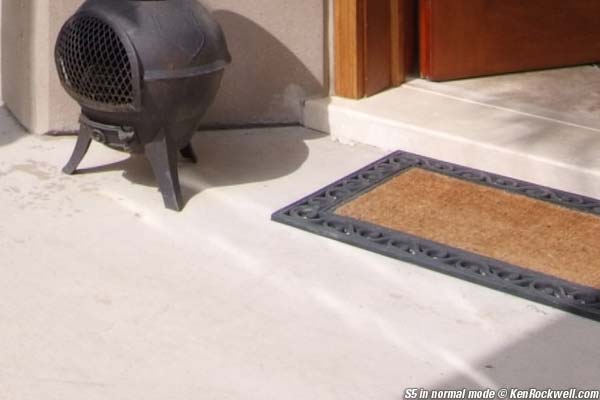Fuji Fujifilm S5
Film Simulation
© 2007 KenRockwell.com
Fujifilm S5 Pro
I got this one here ($1,899 and free shipping). I'd have gotten it here or here, too. It helps me publish this site when you get yours from those links, too.
More Nikon Camera and Lens tests.
back to top of Fuji S5 Review.
April 2007
The Fuji S5 has some color modes that attempt to mimic the look of film. They work very well mimicking portrait and wedding negative film, but work poorly mimicking good slide film.
Each film simulation mode has tweaks within that mode. The dynamic range and other settings become unavailable if using a film simulation mode. To make the similar tweaks, you can set them inside each film mode.
I was hoping I could get the look I love from Fuji's Velvia 50 film out of the S5. Nope, the slide film simulation mode looks like a bad scan of a slide, certainly not like film and not like Velvia 50
These are the five film simulation modes as described by Fuji:
F1: Negative film, long highlight shoulder.
F1a: slightly more saturated version of F1.
F1b: Smoothes skin while pumping up other colors compared to F1.
F1c: Sharper than F1.
F2: Slide film.
Each of these modes may be tweaked +/- 2 from their defaults for saturation (the menu says Color), contrast (the menu says Tone) and sharpening.
Unfortunately the one mode whose saturation can't be increased beyond its own default is the F2 mode.
The F1 modes look very similar to the standard mode, and they all look like portrait negative film.
The F2 mode is completely different than anything else in the Fuji S5. Sadly the biggest problem with the F2 mode is that it hard clips the highlights and shadows, which is why it looks like a bad scan of a slide instead of like a slide. Even if I liked the F2 colors, you lose shadow detail into clipped black, and the highlights clip without the benefit of the film-like shoulder.
Here are some examples:
 |
 |
 |
 |
 |
 |
Fuji S5 Film Simulation Modes.
The "High Color" version of the S5 is its most default mode, but with the saturation as high as it goes. That's usually how I shoot it. Left in default it's very similar to the other F1 modes.
The F2, to my wild tastes, looks the best, but, unseen at this size, the shadows are clipped. Let's compare the Fuji S5's F2 mode to other cameras as I usually shoot them in more-saturated modes:
 |
 |
 |
 |
Comparison of cameras in more vivid settings.
The Canon 5D is the most vivid, because I had it set to +3 saturation. None of the others go past +2. The Canon 30D and Rebel XTi have similar controls.
Next I prefer the Nikons.
The Fuji is least vivid, and its F2 mode is cursed anyway.
The F2 mode could be great, but it's not.
I was hoping Fuji's wizards would simulate the look of Fuji Velvia 50, but what they appear to have done instead is some trivial straight-line curve mapping.
Instead of preserving the highlights and shadows as film does with a curved shoulder and toe, this F2 mode simply clips off anything brighter or darker than certain levels. (The correct way to implement this mode would have used curved toes and shoulders, not a straight-line clip.)
If the S5 had provisions for custom curves I suspect someone could program some really nice things, but unlike the Nikons (even the D40), the S5 has no ability to allow users to program their own curves.
Fuji S5 Normal mode, color set to HIGH. Rollover to see F2 mode.
The F2 mode would be nice, but as the histograms plainly tell, it hard-clips both highlights and shadows. You can see that as the washing-out of the concrete and door threshold in the foreground. You can see the shadows lose detail in the upper door and the shadows in the bushes.
Here are the clipped highlights, which is sad because the dynamic range advantages of the S5 are lost in the F2 mode.
Crop at 100% from above. Rollover to see F2 mode. See how the highlights look weird, like old pizza, in the F2 mode? Different brightness levels on the concrete take on different hues in the F2 mode. This is unnatural. That's because they are clipping. Steal these JPGs and look at the histograms if you're curious.
Crop at 100% from above. Rollover to see F2 mode. See how the shadows lose detail? That's because they are clipping close to 0,0,0 black. Steal these JPGs and look at the histograms if you're curious.
Yes, you could carefully adjust lighting to match the rendition of the Fuji S5, but then why bother paying for the S5? Worse, unlike the Nikons which automatically map their contrast to the subject's dynamic range, the film modes of the Fuji S5 appear to be fixed. You would have to be an expert to match your lighting to the curves of the F2 mode for the best results.
Sadly this shadow clipping looks like a slide scanned on a cheap scanner with insufficient dMax, and the highlights clip like a primitive digital camera from a few years ago. This is the curse which makes this mode usually look bad.
Velvia 50 looks much better than this on the light table. I can see shadows down to zone I, but not on the S5.
F2 mode never says it's trying to match Velvia; Velvia 50 just happens to be my standard of excellence. The clipping on the highlights and shadows look worse, to me, than any of the excellent Fuji slide films.
PLUG
If you find this as helpful as a book you might have had to buy or a workshop you may have had to take, feel free to help me continue helping everyone.
It also helps me keep adding to this site when you get your goodies through these links to Ritz, Amazon and Adorama. I use them and recommend them personally .
Thanks!
Ken
Return to top of Fuji S5 Review.
Caveat: The ads below come from a third party and I don't see or approve them. They are sent to your screen directly from a third party. They don't come from me or my site. See more at my Buying Advice page. Personally I get my goodies at Ritz, Amazon and Adorama.







